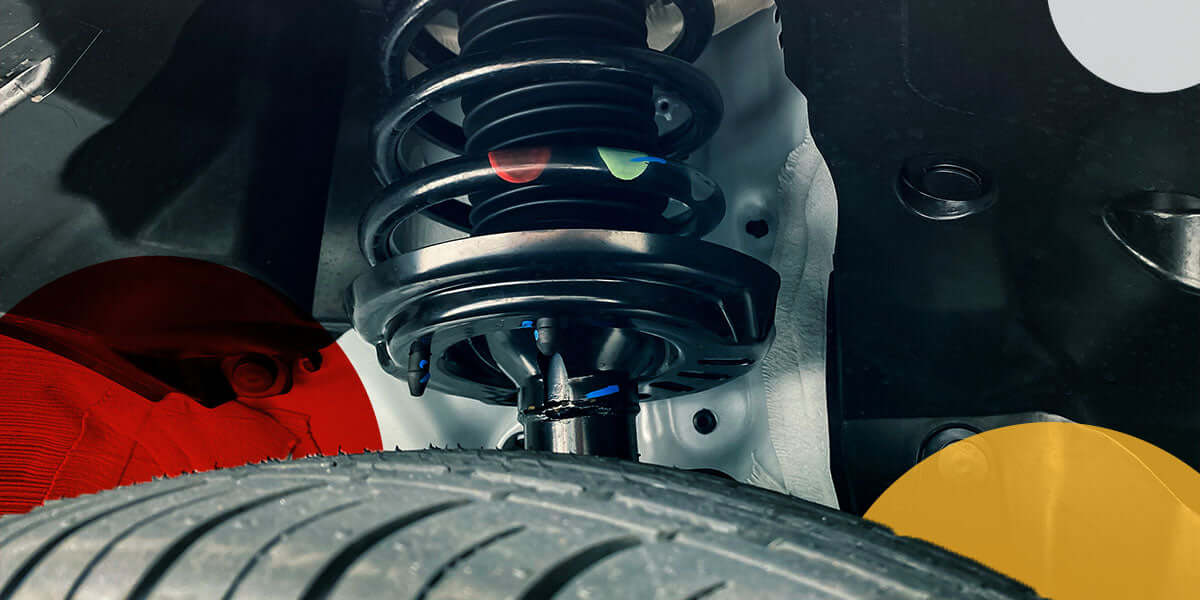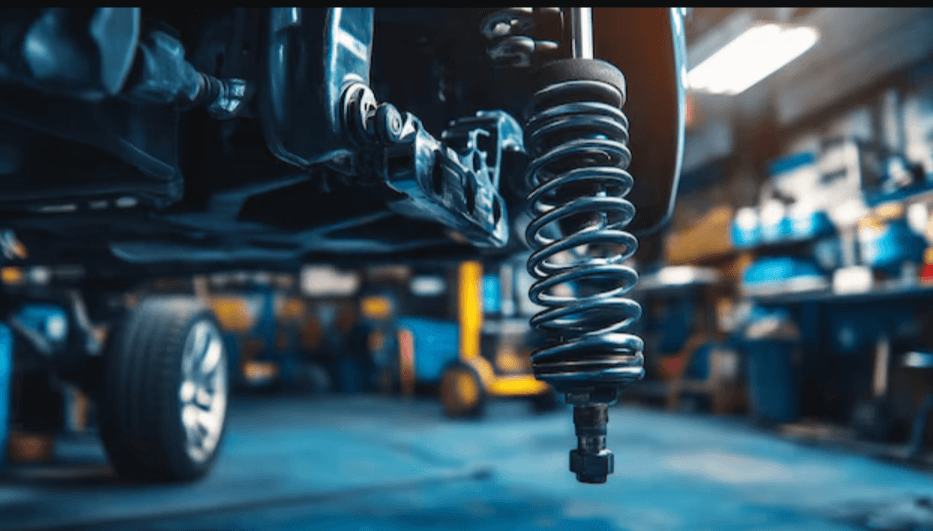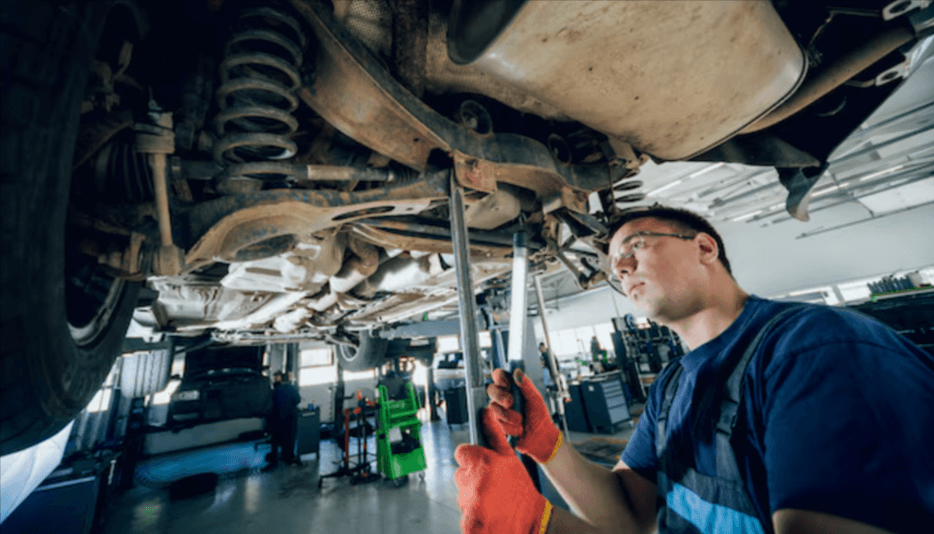Struts and shocks are an integral part of your vehicle's suspension system. They play a pivotal role in ensuring a safe and smooth ride. Identifying potential issues with these components is crucial for maintaining optimal vehicle performance. Gradual changes take place before you may realize the shocks and struts are wearing down, and recognizing the warning signs is crucial in maintaining a smooth, controlled ride.
If you are wondering how to tell if a strut is bad, we can help. From unsettling vibrations and unpredictable handling to extended braking distances, there are many common symptoms of bad struts and shocks. Luckily, you can tackle the situation in a proactive way.
How Shocks and Struts Work
These parts work up to 1,900 times per mile — that's 75 million times for every 50,000 miles your vehicle clocks. While they are independent components and differ in physical makeup, both shocks and struts work to dampen shocks in a car's suspension system. These parts are often referred to interchangeably, but they have major differences and one cannot be a substitution for the other.
How Do Shocks Work?
Shock absorbers are tube-like parts that are filled with hydraulic fluid. Inside the tube, a piston moves up and down to absorb the kinetic energy that the car's suspension movement creates. They primarily work to control the vehicle's bouncing and oscillations after hitting a disturbance. Shocks generally have a simple design and work together with other suspension components.
How Do Struts Work?
Struts are more complex and consist of a shock absorber surrounded by a coil spring in a single unit. As an integral part of the overall suspension system, struts dampen the shocks while providing structural support to the suspension. They also help maintain proper alignment and contribute to your car's handling characteristics during cornering and braking. You will typically find these components on the front of the vehicle suspension.
What Do They Do?
Struts and shocks work together to stabilize your vehicle's movements, helping you control the car. While they do not support vehicle weight, worn shocks can strain the springs and other essential suspension parts. Additional purposes of these components include:
- Contact: These parts help maintain the tire's contact with the road.
- Movement control: They prevent tires and wheels from excessive up and down movements. They also help control your car's body movement as you drive, like bouncing or side-to-side rolling.
- Stabilizer: Shocks and struts contribute to vehicle stability on turns, braking and acceleration.
- Added comfort: They absorb jolts and bumps from irregular road surfaces to provide a more comfortable ride.
- Tire support: Struts and shocks that function correctly support longer tire life since they help support impact and curb excess vertical movement.
Do All Vehicles Have Them?
If your car has a strut on the front left wheel, it will typically have one on the front right wheel, but it is possible that your vehicle has shocks on one axle and struts on another. Most modern-day vehicles feature struts on the front axle with shocks on the rear axle. It is rare that a car will only have shocks.
To find out what your vehicle has, check the owner's manual in the chapter on the suspension setup. You can also look under the car or ask a technician to confirm and ensure your shocks or struts are still in good condition.
Signs of Bad Struts and Shocks
Pay close attention to how your vehicle behaves as you are driving. If you notice excessive bouncing, that is often a sign that something is off with your shocks. Also, take note of any unexpected noises or a noticeable increase in braking distance.
Many symptoms of wear on struts and shocks are relatively easy to detect. If you notice any of these signs, then you know it is time for a change:
- Excessive bouncing: When a vehicle does not settle after hitting a bump and continues to bounce, the shocks might not be absorbing impact efficiently. This instability can also become evident when you are driving at highway speeds.
- Poor handling and control: If the vehicle rolls or sways when you are cornering, it feels like you are not in control. This is especially evident when you take a turn and feel the vehicle tipping more to one side.
- Nose-diving during braking: The car's front end dips when you hit the brakes. You may only notice this when you do an emergency stop.
- Uneven tire wear: When a vehicle bounces a lot, tire wear accelerates, cupping or scalloping the tires. Unusual tire wear also throws off vehicle alignment, which can lead to a whole different set of challenges.
- Unusual noises: Listen for a clunking or knocking sound caused by metal-to-metal contact.
- Longer stopping distance: If it takes your car longer to stop than usual, you should check the struts and shocks as soon as possible.
- Vehicle sagging: Note any rear squat during acceleration. This happens when the car's momentum transfers to the rear.
- Fluid leaks: Excessive hydraulic fluid leaking from shocks or struts indicates the seals are failing. Look out for clear or light brown liquid outside the shocks or struts.
- Steering wheel vibration: A slight vibration is normal, but if you feel vibrations that mimic driving on a bumpy road, your steering stabilizer, struts or shocks are worn.
- Cracking shock covers: Look at the rubber shock covers on the top and bottom of the shocks. Any cracking, peeling or general off-center appearance can indicate wear.
What Contributes to the Wear?
Several variables can add to the wear and deterioration of struts and shocks over time:
- Mileage: The more you drive, the more wear your struts and shocks will experience. Vehicles that have more miles on them may see quicker deterioration of these essential parts.
- Road conditions: Rough roads and potholes can put extra strain on struts and shocks.
- Driving habits: Any aggressive driving, like hard braking, sharp turns and sudden acceleration, can add stress to these parts, leading to wear and tear.
- Vehicle weight: Carrying heavy loads or frequent towing can make these parts wear down faster.
- Age: Even on vehicles with less miles, struts and shocks can deteriorate over time due to aging materials and exposure to environmental factors.
Driving on Bad Struts
You may be wondering how long you can drive on bad struts. As a rule of thumb, driving on bad struts for an extended period of time is not recommended. Any concerns related to your struts should be addressed promptly to maintain your vehicle's safety and performance.
Driving on worn or damaged shocks and struts has a noticeable impact on handling and safety. In day-to-day driving, you might not immediately notice some of the symptoms of bad shocks and struts, like dwindling steering precision and vehicle stability. When you continue to drive in these circumstances, you will likely experience reduced handling, especially as you brake, turn or drive over speedbumps. The extra movement in the vehicle can make long drives more fatiguing.
Continuing to drive on worn or damaged struts can damage your car's suspension components. Parts like tires, control arms and steering components can wear out quickly because of the increased stress. Driving on bad struts can also keep modern safety features from responding like they should, including anti-lock brakes, various control systems and automated braking.
Ultimately, driving with bad struts poses safety risks. Your car has less stability, compromised braking and unpredictable handling, which can decrease your response time and increase the likelihood of accidents.
Checking for Worn Struts and Shocks
Most safety-critical chassis components wear out gradually over time. How soon depends on environmental conditions, driving style and road quality. The symptoms of bad struts and signs of bad shocks may also indicate another problem with your vehicle. To rule out any other component issues, you can do a simple inspection to confirm your suspicions.
Visual Inspection
Start by visually inspecting your car's struts and shocks. Standing in front of the vehicle, look for any signs of oil leaks, indicating a damaged shock absorber. Check the rubber bushings and mounts for cracks, tears or excessive wear. Inspect the coil springs for signs of corrosion or breakage. Moving to the rear of the car, repeat these steps.
When checking the strut mounting, ensure no movement or noise is coming from it. Physical signs of bad struts include excess oil on the component or any noticeable corrosion. You can tell if shocks are bad when you notice any dents, rust or other damage to the shock absorber.
The Bounce Test
After a visual inspection, you can perform the bounce test to assess these components' condition further. Start with one corner of the vehicle and push down firmly on the bumper. Push down as hard as you can, then release, and do this on every corner of the car.
Observe how the car responds to each release. If your vehicle quickly returns to its original position with minimal bouncing, your struts and shocks are in good condition. If the car still bounces several times or oscillates excessively, that is a sign these parts need replacement.
How to Choose the Right Components
Various factors play a role in determining which shocks or struts to get for your vehicle. Take the time to assess the following factors to help you make the right choice:
- Vehicle brand: Identify your exact make and model, as different cars may need specific types of shocks or struts. You can also consult the owner's manual for recommended components.
- Driving terrain: Your typical driving conditions help determine which types of these parts you need.
- Load bearing: If you use your vehicle to tow or haul heavy loads, your shocks take on a lot of strain, which affects the type of shocks required.
There are several kinds of struts and shocks that meet various driving needs and preferences, including:
- Magnetic shocks and struts: These are active suspension systems for cars and trucks, using magnetorheological fluid in a monotube body that responds to electronic resistance signals.
- Gas-charged shocks: The nitrogen gas inside these shocks helps prevent the foaming of the hydraulic fluid inside the shock absorber. This improves responsiveness and reduces fade during heavy use.
- Adjustable shocks: Performance adjustable shocks allow you to adjust the amount of dampening of the shock absorber.
Replacing Struts and Shocks
The life span of these components varies depending on a few factors. On average, they last at least 50,000 miles and usually much more. Check these components on the same schedule as you complete your wheel alignment and tire rotations. When you confirm that the symptoms of bad front or rear struts relate to these components, it is time to change the parts.Double-check the condition of parts like rubber bump stops, bearing mounts and shock boots that connect to your struts, too.
Gather a jack, jack stands, a socket set, wrenches, a pry bar and the replacement struts or shocks. Keep your car's service manual on hand for specific instructions, since this process can vary from one car to another.Always work on a level surface, wear the appropriate safety gear and use the proper lifting equipment.
Here's a step-by-step guide for replacing shocks and struts:
- Lift the car, support it with jack stands and remove the wheels.
- Loosen and remove the bolts and secure the old struts or shocks. Pay attention to the orientation and placement of any mounting hardware and brackets.
- If needed, use a pry bar to separate the shock or strut from the steering hub or control arm.
- Attach the new struts or shocks, ensuring they are correctly aligned and tightened to the manufacturer's specifications. Reattach any mounting hardware and brackets.
- Put the wheels back on and lower your vehicle. Make sure to tighten the lug nuts to the recommended torque before you test-drive the car to assess the improved ride quality.
- After replacing the struts and shocks and going on a test drive, get a professional wheel alignment to ensure your tire wear and handling are normal.
- Keep a record of the replacement date and mileage for future reference. Continue with regular maintenance to enhance your vehicle's safety and performance.
Shop Strutmasters for Replacement Parts
Understanding the common symptoms of bad struts and shocks is about more than vehicle maintenance. It is also about preserving your peace of mind every time you hit the road. These critical components play a pivotal role in maintaining stability, control and comfort. Recognizing the signs of failing components empowers you to take timely action.
When you need replacement parts, choose one of the most trusted names in the industry. For over 20 years, Strutmasters has offered expert service, high-quality materials, trusted manufacturing and excellent product warranties.
Shop our online store today to place your order. Have a few questions? Contact us online, and one of our ASE-certified technical support team members will be happy to help. You can also find answers to FAQs on our site.









